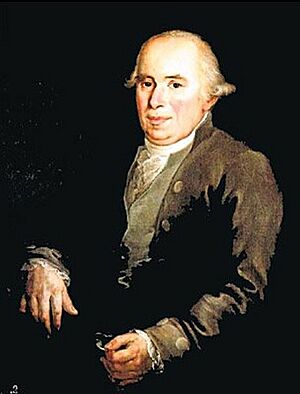José Camarón Bonanat facts for kids
José Camarón Bonanat was a talented Spanish artist. He was a painter, a draftsman (someone who draws plans), and an engraver (someone who carves designs onto surfaces). He was born in Segorbe, Spain, on May 18, 1731. He passed away in Valencia on July 14, 1803. Some old records spell his last name as Boronat.
Contents
Early Life and Art Training
José's father, Nicolás Camarón, was a sculptor. He gave José his very first art lessons. Later, in Valencia, José continued to learn and grow as an artist.
He studied with his uncle, Eliseo Bonanat, who was known for making tiny, detailed portraits called miniatures. José also learned from Miguel Posadas, a painter who was also a friar. In 1752, José moved to Madrid to finish his art education. At first, he focused on painting miniatures and landscapes. He also copied famous paintings by Baroque masters like Titian, Rubens, and Murillo to learn their techniques.
Becoming a Director of Art
In 1754, José Camarón returned to Valencia. He showed his art at the new Academia de Bellas Artes de Santa Bárbara. He was so good that he became a professor there.
He stayed in touch with the art world in Madrid. In 1762, he became an honorary member of the Real Academia de Bellas Artes de San Fernando. Soon after, he helped start the Real Academia de Bellas Artes de San Carlos de Valencia. When the director of painting, Cristóbal Valero, passed away, José took over his role. From 1796 to 1801, he was the General Director of the academy. He later resigned because he had to travel to Madrid for eye treatment.
Important Art Projects
José Camarón was good friends with Francisco Pérez Bayer, a lawyer and writer. Pérez Bayer asked José to decorate the church of Saint Thomas of Villanova in Benicàssim. This big project kept José busy from the late 1760s until 1776. He also helped create many paintings for the Basilica of San Francisco el Grande in Madrid.
Other important works include the altarpieces (decorated panels behind altars) at Valencia Cathedral. He also started painting frescoes (wall paintings) at Segorbe Cathedral in 1800. He passed away before finishing them, so his son, Manuel, completed them in 1806.
Even though he painted many religious works, José is best known for his genre scenes. These are paintings that show everyday life. They are in the Rococo style, which is light and decorative. He also designed illustrations for a 1777 edition of the famous book Don Quixote.
Family Life
José Camarón married Juliana Meliá in 1758. They had five children together. His eldest son, Manuel, helped him finish the frescoes at Segorbe Cathedral. Another son, José Camarón y Meliá, also became a painter, following in his father's footsteps.
Images for kids
See also
 In Spanish: José Camarón Boronat para niños
In Spanish: José Camarón Boronat para niños



